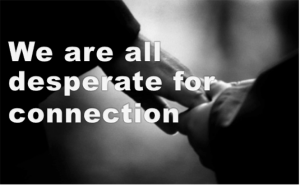Why Connection Is Easier To Heal Than You Think. . . And How To Do It!
https://savethemarriage.com/stmblog/wp-content/themes/corpus/images/empty/thumbnail.jpg 150 150 Lee H. Baucom, Ph.D. Lee H. Baucom, Ph.D. https://secure.gravatar.com/avatar/669b7e375d93f77521ddaba08adb8063?s=96&d=blank&r=pgJill and Steve were similar to lots of other couples I have seen. Both were deeply hurt and angry with the other. Neither felt loved or cared for. Both felt deeply disconnected. But Jill dragged Steve into my office, hoping for a change. Steve was sure that nothing could be done, telling me “it just isn’t meant to be. If it were, we would not always be so hurt and angry.”
While Jill was hurt, she was still hopeful that something could change, that there was some solution to this painful spot. She felt no connection, but still yearned for that connection. So even against my advice, she begged Steve to come for therapy. On the phone, I warned her that forcing someone into therapy was no way to start the therapy process. I asked her to consider whether Steve would be able to even engage in therapy if he felt forced. And in spite of this, Jill scheduled an appointment and somehow “arm-twisted” Steve into joining. . . for 1 session. He refused to return, saying “What’s the use?”
He did, however, state that if Jill continued, he didn’t care. And this was an opening in my mind. Slight, but an opening. While he did not see any hope (so he stated), he would not get in the way of Jill trying to do something.
And Jill did return. For weeks, we talked about their relationship. I gave Jill some different ways of thinking about relationships in general, and there relationship in specifics. She began to see where they had become disconnected — and also saw some ways to reconnect. I wondered if she could use the advice to save her marriage, especially given the resistance I saw in Steve.
Still, I have seen many relationships come back from the ashes — often surprising me, and I have seen lots of relationships! So, I gave Jill some coaching to approach the situation slowly and calmly. I worked with Jill to help her carefully begin the process of reconnecting.
While Jill wanted connection, she didn’t really believe much could change. But desperation sometimes moves us to act beyond our hopes, to pursue even a glimmer of hope.
After a month of coaching, Jill decided she had the tools and wanted to just continue working at it. In that final session, she told me she was not particularly hopeful, but still wanted to give it a go. I gave her my blessings and told her to let me know how things went.
In a nutshell, this is the advice I gave Jill:
 1) Humans are built for connection. We are wired to be in a deeply connected relationship with someone else. When the connection is not there, the hurt is so deep that it comes out as anger. But it is really deep hurt — which still indicates a desire for connection.
1) Humans are built for connection. We are wired to be in a deeply connected relationship with someone else. When the connection is not there, the hurt is so deep that it comes out as anger. But it is really deep hurt — which still indicates a desire for connection.
2) When people are hurt, they resist connection because they fear the hurt. People are desperate for connection, but even more desperate to not feel the pain anymore. So, they reject attempts at reconnection. . . at least initially.
3) Attempts at connection should start slowly, be low-key, and cannot come from your own desperation to connect. Ironically, a relationship is made of two people are desperate for the connection, which is why a marriage crisis throws people into such a quagmire. Each feels the pain, and neither can easily move beyond the pain. Each feels the connection, and neither can move toward the other in connection.
But if one can take a different path and set aside the hurt, change is possible. Desperation never feels like genuine connection, so that person has to stay calm. Huge acts of connection feel insincere and are usually unsuccessful, but small acts can begin to melt the ice.
4) Because we want connection, once the ice melts, reconnection can happen very quickly. Deep hurt that comes out as anger can make it appear impossible to be close. But once the reconnection starts, icy-cold can quickly become warm, which even more quickly becomes a heated connection.
This is a fact that used to surprise me. I couldn’t understand how such an angry relationship could turn around so quickly. But once I realized that the reason was because our need for connection is so deep, we are basically wired for connection, and once that spot is hit, the relationship takes off.
Which is my point of noting this! When we can move beyond our hurt and pain, and when we can reach out and work on the connection, we can heal the disconnection. Because of our innate need for that connection, once we remove the barrier, we come together quickly. It is almost like two magnets, held apart by a barrier. The pull between them can seem absent. But if the barrier is removed, the magnets pull together with an acceleration that can be surprising.
But what about Jill and Steve?
Over the next few months, I wondered what happened, but was not particularly hopeful. Then, four months later, Jill contacted me and asked if she could come in. I scheduled an appointment, and was a bit surprised to enter my waiting room and find Jill and Steve on the couch, leaning into each other and laughing about an article in a magazine.
During that last session, Jill and Steve told me a story of reconnection and healing. Jill was true to her word. She stayed calm and continued to work on reconnecting.
At first, Steve was very resistant, but he found himself slowly melting into the conversations and connections. Then, Steve began to take a risk and worked to return the connection. This sent them on a recovery path that was of exponential growth as each effort compounded the efforts already taken.
We wrapped up the session talking about strategies for making sure that the disconnection never happened again. And for the last couple of years, I have received a card on their anniversary, assuring me they had been doing just that.
- Posted In:
- News
Lee H. Baucom, Ph.D.
Dr. Baucom is internationally known for his methods and approaches to saving marriages. For over 25 years, Dr. Baucom has been helping people around the world to save, restore, and create the relationships they desire and deserve. He is the author of the book, How To Save Your Marriage In 3 Simple Steps, and creator of the Save The Marriage System, as well as numerous other resources.
All stories by: Lee H. Baucom, Ph.D.